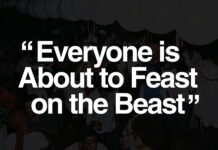There are four classic versions of the song known to the world as “Video Clash.” They were released by four different producers (most of whom knew each other and liked each other), though not the producer that most say originally made it.
“Video Clash” is one of my favorite tracks, and one of the few I can listen to and genuinely appreciate across multiple cover versions. “Video Clash” probably went pretty far in advancing what people today consider the Chicago aesthetic – that raw’az’hell sound of machines that barely work, somehow working harmoniously.
Over the years, 5 Magazine has had the opportunity to interview nearly everyone involved in the story (though not all commented on the record). Despite the saga having played out in numerous forums in the past, this is still one of the question I get asked the most: “Which of the four versions is the real ‘Video Clash?'”
I’m not going to be goaded into playing Maury, though. All but one party agree on the paternity. The more fascinating story is how four versions of the same track each became in time wildly popular – in many cases the most popular tracks of some of these guys’ careers. How did a track evolve from a living floor experiment into a classic four times over?
This isn’t Maury but… it’s complicated.

01: The Original (Dance Mania, 1988)
The story has always been very consistent, and has reached near-consensus over the years. Marshall Jefferson made the original “Video Clash” in his living room in front of a group of friends. Marshall’s tracks were in high demand among DJs in the era when a smash like Phuture’s “Acid Trax” could be played in clubs for years before it was pressed to record.
“I did a lot of songs then that were played in the clubs and never came out,” Jefferson told Rees Urban in an August 2009 5 Magazine interview. “At that time I was giving all my rough demos to Ron Hardy and since he was there, Lil’ Louis called dibs on the new hot tune. He also told me not to give it to Ron Hardy.”
“The only problem was that when the record came out, it didn’t have my name anywhere on it.”
Marshall said he lost the original tape but could remake it. “I still remember the keyboards I used, but I don’t know if I can duplicate that raw sound because it was done in my living room on cheap equipment.”
The Lil’Louis-credited “Video Clash” was a smash, and because of its title (“The Original…”) is often mistakenly regarded as some kind of master recording from which the others are derived.
02: Tyree: Video Crash/Acid Crash (Rockin’ House, 1988)
Tyree Cooper’s entry in the “Video Clash” saga has a tortured history of its own. Released on Rodney Bakerr’s seminal Rockin’ House Records, “Video Crash” (note Crash, not Clash) is maybe best known under the name “Acid Crash” – a name given by a bootlegger on the East Coast.
“By me meeting Marshall Jefferson prior to hearing ‘Video Clash’ from Marshall,” Tyree told 5 Magazine’s Czarina Mirani in December 2013, “Mike Dunn and I decided to do our own version of that track. Mike did one called ‘Magic Feet’ and I did one called ‘Video Crash.’
“Once all three were released, Mike Dunn’s outsold mine and Lil Louis’, and mine got bootlegged and renamed ‘Acid Crash’ by this guy named Jeffery Collins or something like that – the MF!!!!”
Both the legit release and the boot have been among what Tyree told us were “my most licensed tracks from my catalog.”
03: Mike Dunn: Magic Feet (Westbrook, 1988)
We have no sales charts to prove the point, but Mike Dunn’s “Magic Feet” was probably the best seller of the “Video Clash” iterations and definitely the most widely heard. If you’ve seen Hoop Dreams, Steve James’ celebrated documentary about two Chicago high school basketball stars, then you’ve heard it too: the graduation party features Arthur Agee’s whole family jackin’ to Mike Dunn’s “Magic Feet.” (The documentary was released in 1994 but was filmed over a five year period.)
Other versions were sampled more (within a few years the evocative 8bit riff had shown up in “House of Love,” “Robi-Rob’s Boriqua Anthem” from C+C Music Factory and others), but for at least the first part of the 1990s, “Magic Feet” was a hallmark in any Chicago House party, as it shaved off some of the edges of Tyree’s and the “Original” versions without losing any of the grit or ferocity. Backed with “Life Goes On” and “So Let It Be Houze!” the whole EP was a landmark, though “Magic Feet” still gets the nod.
04: DJ Funk #1: Video Clash (Dance Mania, 1995)
The second iteration dubbed “The Original,” DJ Funk’s “Video Clash” came home to Dance Mania in 1995 on one of the label’s most underrated EPs. Mike Dunn’s “Happy Feet” could have been adapted to Footwork if anyone tried, but nobody did until DJ Funk brought “Video Clash” back.
“Me and Ray [Barney, Dance Mania’s owner] spoke about remixing it,” Funk told me in a 2014 interview. “The way I like to make a lot of my tracks, I’ll ask myself, ‘Can I see myself playing it out in the future?’ I see them down the road as classics. But then again I make some that just sound great for the time too.”
Funk returned to the sound with a more subtle reference to “Video Clash” in the 1997 release “Work That Body.”
Whether it’s because of the Ghetto House sound he pioneered enjoying a renaissance or something more mysterious, Funk’s remix of “Video Clash” is probably the most popular one being played by jocks today – popular enough for Dance Mania to arrange for a reissue two years ago. Like with Mike Dunn’s entry, “Video Clash” shouldn’t overshadow the other tracks on this powerful EP, including “Acid Frequency,” “Bitches” and “Jerk It.”
Originally published in 5 Magazine Issue #135 featuring Kon, Stephanie Cooke, Gareth Whitehead, Video Clash, 3YB Music Fest and more. Become a member of 5 Magazine for First & Full access to everything House Music for just $1 an issue!























awesome article.
[…] https://5mag.net/features/story-video-clash/ […]
To be honest i find Tyree’s version a little boring. But, those 909 drums… They sound soo good.
[…] I heard “French Kiss,” I went crazy hearing that with a beat going slow. Songs like “Video Clash” and “Magic Feet” and “Armani Trax” and “Computer Madness.” […]
[…] first time I heard “French Kiss,” I went crazy hearing that with a beat going slow. Songs like “Video Clash” and “Magic Feet” and “Armani Trax” and “Computer Madness.” I’m hearing all these […]
[…] it could power a b-side or cult hit from any of a number of Chicago House legends (I keep hearing Tyree Cooper’s bassline from “Acid Crash”). Suspended overhead is an overheated diva-style vocal – throaty but not lewd, it lifts this […]